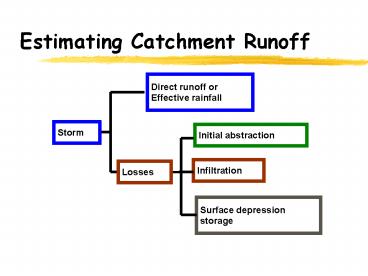Estimating Catchment Runoff
1 / 10
Title:
Estimating Catchment Runoff
Description:
Estimating Catchment Runoff Direct runoff or Effective rainfall Storm Initial abstraction Infiltration Losses Surface depression storage Infiltration methods Soil ... –
Number of Views:191
Avg rating:3.0/5.0
Title: Estimating Catchment Runoff
1
Estimating Catchment Runoff
Direct runoff or Effective rainfall
Storm
Initial abstraction
Infiltration
Losses
Surface depressionstorage
2
Infiltration methods
- Soil Conservation Service (SCS) Curve Number
(CN) method - Hortons equation moving curve method
- Green Ampt model
3
SCS Curve Number method
CN depends on soil type and pre-wetting
inches
P(t) depth of rainfall Q(t) depth of
runoff Ia initial abstraction S
potential storage CN curve number ? 100
mm
4
Horton equation
5
Green Ampt model
where Mmoisture deficit S suction head K
hydraulic conductivity
6
Rainfall-Runoff models (1)
Rainfall
Effectiverainfall
Infiltration Model
Runoff
Losses
Catchment Model
Losses subtracted from rainfall to get effective
rainfall which is then applied to catchment.
7
Rainfall-Runoff models (2)
Losses and infiltration calculated along with
runoff as part of Runoff Model
Rainfall
Runoff
Catchment Model
SurfaceDepressionStorage
Losses andinfiltration
8
Calculating the Runoff (1)
Runoff from pervious and impervious fractions
computed and added together
Flow lengths can be- (a) equal (b)
proportional (c) user supplied
9
Calculating the Runoff (2)
Symmetrical catchmentArea 2.2 ha
Overland flow length can be estimated as area
divided by length of stream bank available for
inflow.
75m
96m
63m
One-sided catchmentArea 2.4 ha
192m
10
Calculating the Runoff (3)
- Overland flow routing choices
- Combine effective rainfall with
- triangular response function
- rectangular response function
- single linear reservoir response function
- Combine infiltration other losses with outflow
from idealized inclined plane.(Similar to SWMM
RUNOFF method)































